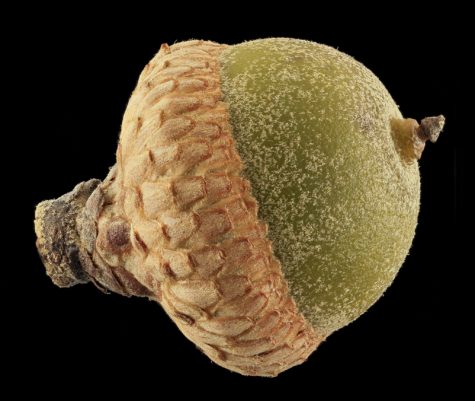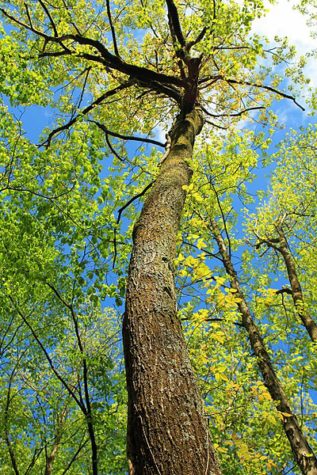
It’s another year of constant “ping ping ping” as the acorns leave the trees in wildly large numbers! I last noticed this happening back in 2017, and I wrote about it then. Might as well revisit that post now!
These early fall days have been especially musical here, in my house under the trees. The mornings ding and clink and the afternoons ping and donk and the nights are broken up by knocks, clangs, and cymbal crashes that startle me awake. (Part of my roof is metal.)
It’s the acorns falling, but in a relative hail storm rather than the usual drizzle. The massive dumping of seeds and occasional strike on the head might suggest I’ve totally pissed off some squirrels.
But squirrels pretty much just make grumpy noises and twitch their tails when annoyed. Instead, it’s the oaks showing off their progeny, with gravity’s help. The trees are shedding fruit as though it’s their last chance to seed the land.
That’s not too far from the truth. It turns out we are in a mast year—the boom of the boom-and-bust cycle describing oak (and beech) tree reproduction. The trees weighted down with acorns this fall (a big oak might produce as many as 10,000 of them!) will most likely support a much lighter load for the next three to five years. This is a parent tree’s best chance to spread her genes and grow the neighborhood forest before lean times commence.
And they truly make the most of it. Like neighbors filling platter after platter for a block party, oaks synchronize their excess fruit production with other oaks in the area. (This doesn’t surprise me: See my post about plant communication here, and this TED talk about trees’ use of electrical signals. Maybe one of these explains how the plants “get together” on acorn delivery. Or maybe there’s an atmospheric or chemical cue that synchs them up, or something else entirely. No one knows for sure.)
So, why the waxing and waning of resources? You, like me, might quickly assume it has to do with environmental factors like temperature and rainfall. It seems logical that when conditions are good, trees would produce more offspring. Acorns start to develop about two years before dropping, and studies suggest a correlation between masting and summer temperatures during that time—warm the year before a mast and cool two years prior, to be specific.
But masting is not caused by certain weather conditions. What’s more likely, say ecologists, is that the boom-bust cycle evolved as a way to manage seed predation. The hypothesis: A series of lean years helps control the size of seed-predator populations (insects, small mammals with big cheeks, bigger mammals with regular cheeks, plus birds). Then when there’s finally a mast year, with its explosion of acorns—sometimes 100 times more than during a non-mast year—there aren’t so many nibblers as would devour every seed that hits the ground. Acorns that escape predation, along with the ones squirrels bury and forget (silly squirrels!), may actually settle into the soil, send down a root in search of water, send up a shoot in search of light, and eventually grow into trees.
In addition, the cycle may let a tree direct much of its energy, toggling to some degree between growth and reproduction. Tree ring data suggest less growth happens during bumper crop years and vice versa.

It helps that the oaks go into overdrive together. Not only does that increase the total number of acorns because there are more trees making them, it boosts the efficiency of pollination—potentially improving each individual tree’s own crop. A mast year consolidates a neighborhood of trees’ reproductive energy to get the highest return (seedlings over fat squirrels) for their joint effort.
Now that I’m thinking about it, last year was rather squirrel deficient in my ‘hood (I notice small animals because my dogs want to eat them all) and the acorn drop was noticeably light. I did much less patio sweeping than I’ve done in recent weeks. And the night music was mostly crickets and car alarms.
As far as Octobers go, I like this year better than last. There’s comfort in the knocks on the roof, the crunch of shells underfoot, the scrabble of creatures in the leaves finding food aplenty. A mast season gives us one last pulse of life before winter comes.
—
Photos:
Acorn: By USGS Bee Inventory and Monitoring Lab [CC BY 2.0 (http://creativecommons.org/licenses/by/2.0)], via Wikimedia Commons
Oak Tree: By Nicholas A. Tonelli from Northeast Pennsylvania, USA (Ferncliff Wildlife and Nature Preserve (6)) [CC BY 2.0 (http://creativecommons.org/licenses/by/2.0)], via Wikimedia Commons
https://practicalselfreliance.com/acorn-recipes/
Maybe you will find an acorn recipe here for your dog as well 😉
I don’t know the author of the recipes, it’s just something I happened to select. I hike frequently and at this time of year the squirrels are dutifully at work collecting acorns and black walnuts (which are also plentiful in the south suburban neighborhoods of Pittsburgh, PA. [No website, just Facebook and Instagram accounts.]